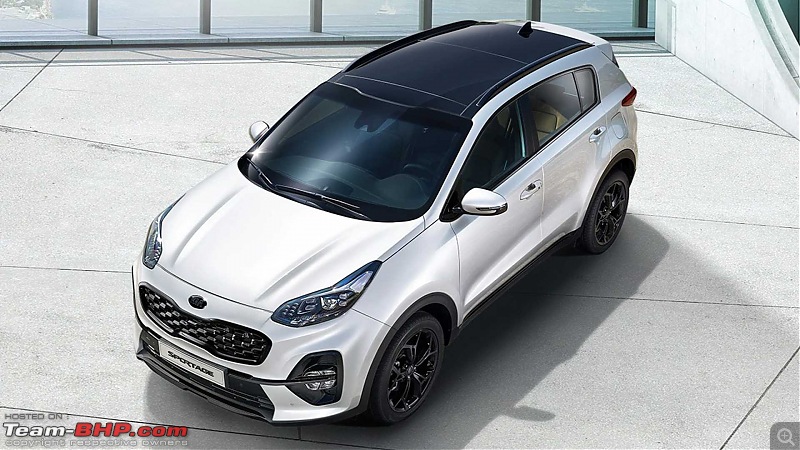| |||||||
| Search Forums |
| Advanced Search |
| Go to Page... |
 |
| Search this Thread |  60,845 views |
| | #31 | ||
| Senior - BHPian Join Date: Apr 2007 Location: LandOfNoWinters
Posts: 2,178
Thanked: 3,008 Times
| Re: Aerodynamics, simulations and the Tesla Model S Quote:
But the effect is more pronounced in the aft side where your aim is to not let the boundary layer get separated from the body. Hence the long trailing edge offers more returns per meter compared to a long leading edge. Regarding the point about Cd. Your question does makes sense since I see a close resemblance with the kinetic energy equation. (In fact I can even derive the drag force equation from kinetic energy equation!) Quote:
 Last edited by alpha1 : 13th July 2020 at 15:47. | ||
| |  (2)
Thanks (2)
Thanks
|
| The following 2 BHPians Thank alpha1 for this useful post: | MegaWhat, Sutripta |
| |
| | #32 | |
| Distinguished - BHPian  | Re: Aerodynamics, simulations and the Tesla Model S Quote:
We have almost forgotten. These days most cars tend to be pretty stable and they are not that much influenced by side winds. But anybody who has ever driven say a VW Beetle at more than 40 km/h whilst being overtaken by a truck, or traversing a bridge with a bit of cross wind, will know what I am on about. These days we would call such handling atrocious if not murderous! For any car its longitudenal stability is susceptible to cross winds one way or the other. How it deals with it is probably more down to suspension, weight distribution and so than perhaps aerodynamics. Although I guess the shape and size of the car side surface might play a role as well Jeroen Last edited by Jeroen : 13th July 2020 at 16:01. | |
| |  (1)
Thanks (1)
Thanks
|
| The following BHPian Thanks Jeroen for this useful post: | MegaWhat |
| | #33 |
| BHPian Join Date: Aug 2017 Location: Bengaluru
Posts: 832
Thanked: 4,143 Times
| Re: Aerodynamics, simulations and the Tesla Model S Thank a ton for writing in layman language on one of the most advanced arts of technology. 5 stars isn't enough for this article, because this is not only a compilation of literature but also a proper simulation project. You have chosen an already well designed car and further optimized it, Kudos  Would you like to comment on aerodynamics of SUVs. Is there any scope for improvment or are they just like helicopters without rotors. Maybe it is too much to ask for, I would appreciate, if you can compare any popular car model from our market and suggest improvement, because people can relate to it. Last edited by Thermodynamics : 14th July 2020 at 04:52. |
| |  (1)
Thanks (1)
Thanks
|
| The following BHPian Thanks Thermodynamics for this useful post: | MegaWhat |
| | #34 | |||
| BHPian Join Date: Apr 2020 Location: Pune/Oxford
Posts: 99
Thanked: 631 Times
| Re: Aerodynamics, simulations and the Tesla Model S Quote:
Profiles with sharp front and sharp aft edges are more efficient at supersonic speeds or close to Mach1. That has more to do with shock waves and area-rules. The wings on most fighter aircraft will have a slightly sharper front edge (also called leading edge) as compared to an aircraft that flies well below the speed of sound. Quote:
Quote:
 . I'll still keep looking though. . I'll still keep looking though.Coming to SUVs, I think its a matter of what is the design intent for that vehicle. SUVs in general are not supposed to go that fast. And if we put a front lip, it will adversely affect it's off-road capabilities. Coming to Land rovers and other SUVs that CAN go fast, I only see a basic spoiler, but I'd like to explore that as well. Will update here If I can get my hands on a good CAD model. | |||
| |  (6)
Thanks (6)
Thanks
|
| The following 6 BHPians Thank MegaWhat for this useful post: | alpha1, Hayek, Slick, Sutripta, Thermodynamics, V.Narayan |
| | #35 | |
| Senior - BHPian Join Date: Jul 2009 Location: Calcutta
Posts: 4,668
Thanked: 6,233 Times
| Re: Aerodynamics, simulations and the Tesla Model S Quote:
Everyone knows of slipstreaming to improve speed etc. Never found discussed what happens to the object in front. Sutripta | |
| |  ()
Thanks ()
Thanks
|
| | #36 | |||
| Distinguished - BHPian  | Re: Aerodynamics, simulations and the Tesla Model S Quote:
Quote:
It has some more information and somebody conducting some interesting experiments and coming to the same conclusion. But the Internet does not agree to this conclusion! Quote:
I sort of think there might be an positive effect, but it is likely to be more theoretical than practical if it exists at all. But then again, I know very little about aerodynamics. We are doing some work using 5G to allow trucks/cars to “platoon”. I am trying to get some information on this effect for the lead truck. Not sure we are looking at this aspect, rather than total fuel saved / congestions minimised. Jeroen Last edited by Jeroen : 14th July 2020 at 13:39. | |||
| |  (4)
Thanks (4)
Thanks
|
| The following 4 BHPians Thank Jeroen for this useful post: | alpha1, Hayek, MegaWhat, Sutripta |
| | #38 | |||
| BHPian Join Date: Apr 2020 Location: Pune/Oxford
Posts: 99
Thanked: 631 Times
| Re: Aerodynamics, simulations and the Tesla Model S Quote:
If a car is being driven at 90kmph, the approaching air hits it at 90kmph and a corresponding high pressure region is created. Now, if the same car is being driven close behind another car, the air that hits it is at a much lower speed (thanks to the wake created by the car in front). So the region of high pressure created in front of the trailing car is lower leading to lower drag. On the question of what happens to the leading car, I can think of the following:
Quote:
Quote:
 . . | |||
| |  (2)
Thanks (2)
Thanks
|
| The following 2 BHPians Thank MegaWhat for this useful post: | Sutripta, Thermodynamics |
| | #39 |
| BANNED Join Date: Mar 2011 Location: hump city
Posts: 1,293
Thanked: 5,892 Times
| Re: Aerodynamics, simulations and the Tesla Model S Excellent thread, MegaWhat. Perhaps you can include the following as well into your simulation model and show us the results : 1) importance of flat underbody - reduces Cd and Cl in one stroke 2) why the side running board areas are extended as low as possible - Gordon Murray's road scraping F1 car can be used as an extreme example 3) how front airdam is different from front splitter 4) wheel air curtains 5) wheelwell air removers 6) separation edges in rear bodywork Last edited by venkyhere : 15th July 2020 at 14:30. |
| |  (1)
Thanks (1)
Thanks
|
| The following BHPian Thanks venkyhere for this useful post: | MegaWhat |
| | #40 | |||
| BHPian Join Date: Apr 2020 Location: Pune/Oxford
Posts: 99
Thanked: 631 Times
| Re: Aerodynamics, simulations and the Tesla Model S Quote:
Secondly, thanks for these points! I read up about these design aspects in detail only thanks to your post! I won't be able to run simulations for each of these situations at this point; maybe sometime later. But I'll share my comments based on some basic reading. 1. Importance of flat underbody. A rough/cluttered underbody basically makes the flow under the car rather chaotic. It's easier for the air to flow over a smooth and flat surface as compared to around pipes, ridges, tubes and suspensions. The effect on drag is rather straightforward. Smoother flow over a smooth flat underbody will end up reducing drag (as it disturbs the air less). Coming to lift though, it's got two steps. First, as the oncoming air is effectively "pinched" into the underside of the car, it's speed increases. This has something to do with the conservation of mass. For example, whatever mass of water goes into a pipe, must also come out - even if the outlet diameter of the pipe is lesser than the inlet diameter. Say we have a one-way, 4 lane road and a camera mounted on the roadside at a fixed point. Let's assume that the cars on the road are distributed uniformly across all lanes. Say the camera counts that in one minute, there are 50 cars that cross it. Now, if the road becomes a one-way 2 lane road, and if there still have to be the same 50 cars per minute "traffic flow rate", every car will have to speed up to meet that "traffic flow rate". If we have a situation where a 4 lane road converts into a 2 lane road, the maximum "traffic flow" is governed by the choking at the 2 lane road. So when the shape of the car forces a fairly big chunk of air through a small gap like the underside, the speed of the air increases. For a smooth underside, this increased speed leads to lower pressure (under the car) and hence, a reduction in net lift. If the underside is cluttered with pipes, these present an obstruction to the air which reduces it's speed instead of increasing it. That's why a smooth underside can help reduce lift by a measurable margin. 2. why the side running board areas are extended as low as possible As mentioned above, the pressure under the car is slightly lower than the ambient pressure due to the faster air. Due to this, the air on the sides of the car can tend to flow towards this underside (flowing from high pressure to low pressure region) leading to some more vortices, disturbance and hence higher drag. The side skirts/running boards help in isolating this low pressure region from the high pressure region. Here's a good representation from a paper: 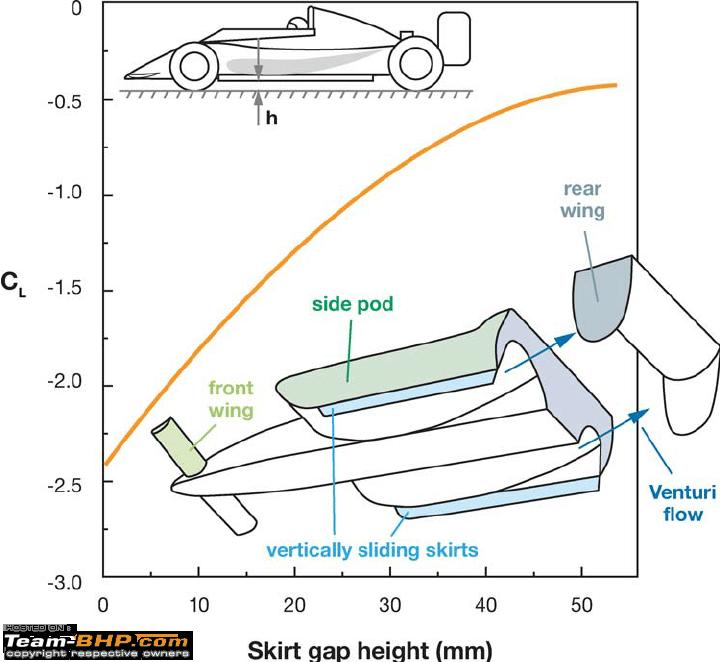 (Ref: https://www.researchgate.net/figure/...fig9_228616843) Effect of side skirt to ground gap clearance on vehicle’s total downforce coefficient. (From Wright 1983.) (Note that the underbody diffuser is called “venturi” in this sketch.) 3. how front airdam is different from front splitter An air dam basically blocks the air from going under the car and routes it over the car instead. The front splitter actively produces downforce due to the high pressure region created by the air dam on top of the splitter and a lower pressure region under the splitter. Here's a website that explains it rather well: https://nasaspeed.news/tech/aero/air...reduce%20drag.: Quote:
Quote:
The airflow around rotating wheels is quite chaotic and can lead to a lot of drag by itself. In addition, this disturbed air can slow down the air that is attached to the sides of the car and lead to an early separation there as well (leading to more drag). A wheel air curtain basically takes some high pressure air (from the front) and routes it around the wheel so as to "energise" the flow that eventually attaches on to the side of the car. This helps reduce drag by ensuring the air stays attached on the car door. I found a good explainer on youtube for this. This guy has some pretty neat videos and performs a few tests with tuft visualizations to understand the impact of various aerodynamic features. It is worth a watch. 5. wheelwell air removers At first glance, it seems to be a way to evacuate the chaotic air behind the wheel, but I'm going to need to look into this in a little more detail. Do you have a particular image or something that you can share as an example? 6. separation edges in rear bodywork These are essentially sharp edges used to do the following: a. Ensure clean separation of flow at the same point on the car at different speedsHere's another video that explains this well: | |||
| |  (1)
Thanks (1)
Thanks
|
| The following BHPian Thanks MegaWhat for this useful post: | venkyhere |
| | #41 | |
| BANNED Join Date: Mar 2011 Location: hump city
Posts: 1,293
Thanked: 5,892 Times
| Re: Aerodynamics, simulations and the Tesla Model S Quote:
It creates a high pressure zone within the wheel well, whilst above the wheel well there is a low pressure zone due to fast flowing 'unhindered' air. This creates needless lift - or in other words, sullies the effect of the splitters in the front, which are busy trying to provide downforce in the front. This problem gets especially magnified, if there are 'cooling vents' for the front brakes on the bumper, because now even more air is in this 'churning zone' between the tyres and the wheel well. Which kind of cars have this kind of 'air removal from wheel well vents' installed most commonly ? WRC. Take a look at this very educative post , some excellent pictures are shown | |
| |  (1)
Thanks (1)
Thanks
|
| The following BHPian Thanks venkyhere for this useful post: | MegaWhat |
| |
| | #42 | ||
| BHPian Join Date: Apr 2020 Location: Pune/Oxford
Posts: 99
Thanked: 631 Times
| Re: Aerodynamics, simulations and the Tesla Model S Got a chance to run a car simulation after an extremely long time. Turns out, the procrastinator in me takes over, as the amount of work that needs to be done increases  . .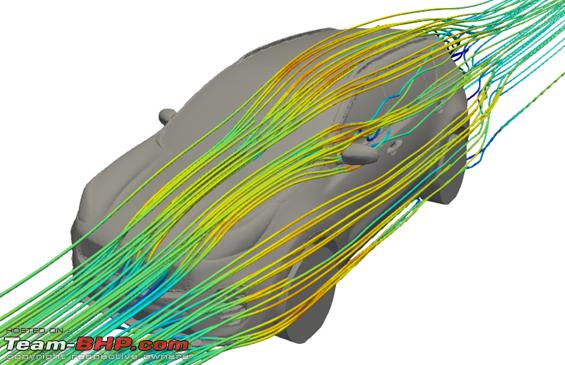 This time - thanks to @Shreyans_Jain and @Thermodynamics for their request Quote:
Quote:
- I scouted for a model of an SUV. Unfortunately (again) I did not find a good enough model for an actual SUV that is widely sold in India. However, I thought maybe a compact SUV might do for now, just for comparison sake. Thankfully, I did find a decent model of a fourth generation Kia Sportage that I could use without much of a hassle. And although it isn't a car that is currently sold in India, we could see it in the market sometime soon. In any case, it seems like a good SUV-esque geometry to compare the Tesla's aerodynamic performance to. Simulation setup:The simulation for the Sportage was setup exactly like that for the Tesla Model S. This is done to minimize the variables and assumptions that go into CFD simulation, thereby maintaining an acceptable level of accuracy and the ease of doing an apples to apples comparison. Results:Let's jump into the results.
Here are some of my thoughts: On lift: Cl vs. speed comparison for the Sportage and Model S 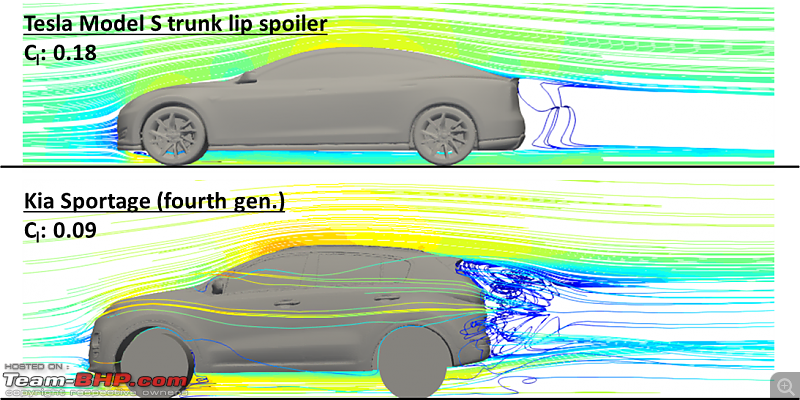 Comparing streamlines along the length for both cars
On drag: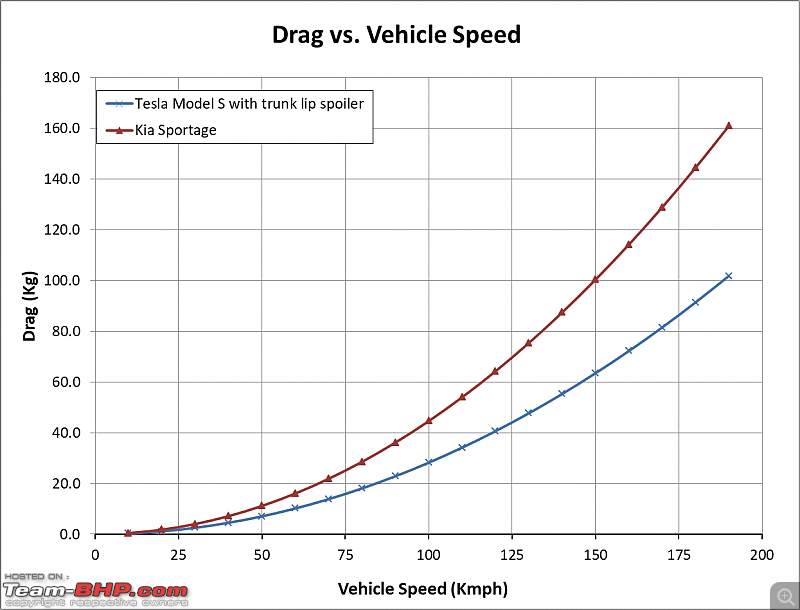 Cd vs. speed comparison for the Sportage and Model S  Drag creating regions around the Sportage 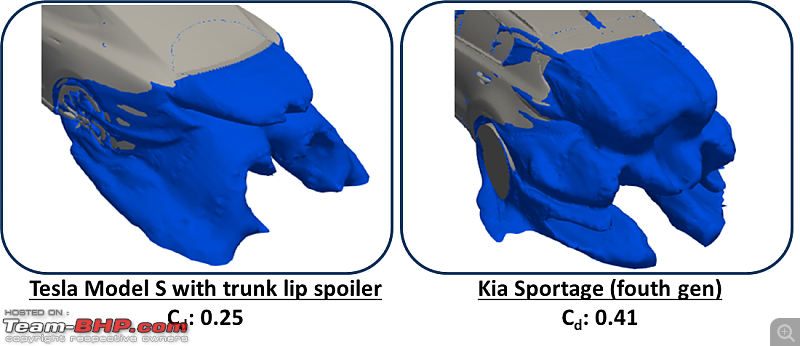 Comparison of drag creating regions in the wake of the Sportage and Model S
On power required to overcome drag:
Other observations:Let's look at the three dimensional streamlines over both cars. It is interesting to see that the Model S has a total of two vortices in it's wake - one to the left and another to the right of the car. The Sportage has a total of 4 vortices in it's wake - two on each side. I'm guessing this is also good in a way because 4 small vortices will tend to consume less energy than two large vortices, but I could be wrong here by a large margin. Overall, the Sportage is designed to be a mini SUV and not an ultra aerodynamic electric sedan. The aerodynamic requirements of this car are significantly different than that of a Model S and it seems to address them well enough. For example, even if the Cd is quite high, the car is capable of pulling through even at high speeds. The power requirement here is going to be mostly governed by many other factors and not aerodynamics. It is also good to see the Sportage have a rather low Cl, despite the sloping roof. It seems the makers have attained a sufficiently good balance between Cl and Cd for the Sportage. Assumptions for the simulation:
I'll keep adding some runs as and when I find the time and models to do so. Fingers crossed I do it frequently.  | ||
| |  (26)
Thanks (26)
Thanks
|
| The following 26 BHPians Thank MegaWhat for this useful post: | --gKrish--, amit_purohit20, apache_aayush, batladanny, CEF_Beasts, GTO, Hayek, jasjotbains, Jeroen, landcruiser123, Leoshashi, mallumowgli, paragsachania, PraNeel, Researcher, sainyamk95, Slick, spd_tkt, sridhar-v, SS8939, SuhairZain, Thermodynamics, Turbanator, venkyhere, VijayAnand1, warrioraks |
| | #43 | |
| BANNED Join Date: Mar 2011 Location: hump city
Posts: 1,293
Thanked: 5,892 Times
| Re: Aerodynamics, simulations and the Tesla Model S Quote:
It is regarding the ORVMs. To your existing models (as is), how hard is it for you to make an "edit" and add some shapes/objects to the existing bodywork ? If it's easy, can you try the following : tiny hemispheres of 2/3 mm radius, stuck to the outer boundary of the ORVM casing, the gap between neighboring hemispheres being some 4/5 mm (like a series of halogen bulbs around a film celebrity's make up mirror) around the periphery of the casing, right at the edge where air leaves the ORVM surface and goes berserk in its wake. I am particularly interested in the difference (between pressure levels revealed by simulations) in "waves of air" hitting the front window glasses, both before & after the mod suggested above. The intensity and frequency of these "waves of air coming off the orvm wake" and hitting the front window glasses, is what I think is the major contributor to wind noise (in stock form, without any rain visor etc installed). Kindly help me with this. | |
| |  (1)
Thanks (1)
Thanks
|
| The following BHPian Thanks venkyhere for this useful post: | spd_tkt |
| | #44 |
| Distinguished - BHPian  Join Date: Jul 2011 Location: Bombay
Posts: 2,034
Thanked: 16,981 Times
| Re: Aerodynamics, simulations and the Tesla Model S What a fantastic thread!! The first three posts are a master class in how to explain a complex topic in a manner that is comprehensible for a layman. Was surprised that the difference in drag coefficient between a Model S and a Kia SUV is as little as what you have found. I somehow had the impression that an SUV would have twice the drag of a streamlined sedan. Was also surprised to learn that the power needed to overcome drag rises with the cube of the speed. I had always thought of power in terms of acceleration based on Newton’s laws - which rises with the square of the speed. This explains why fuel efficiency in SUVs tails off so quickly with speed. To your point on the value of smooth underbodies, I wonder what the impact of the difference between a typical Indian road (usuallly cement concrete with loads of patches and undulations) is compared to smooth Tarmac. So we probably suffer a double negative impact - from the larger ground clearance needed to tackle our road surfaces and the lack of smoothness of the roads. Look forward to seeing more simulations from you on this thread. |
| |  (2)
Thanks (2)
Thanks
|
| The following 2 BHPians Thank Hayek for this useful post: | MegaWhat, Thermodynamics |
| | #45 |
| BHPian Join Date: Aug 2017 Location: Bengaluru
Posts: 832
Thanked: 4,143 Times
| Re: Aerodynamics, simulations and the Tesla Model S Thanks for the analysis, indeed it justifies why some of our SUVs have a decent fuel efficiency. Hayek has aptly said all what I had to say. Amazing thread!. Really appreciate your efforts, I guess it takes days to run every scenario. What next, a convertible ? |
| |  (1)
Thanks (1)
Thanks
|
| The following BHPian Thanks Thermodynamics for this useful post: | MegaWhat |
 |





